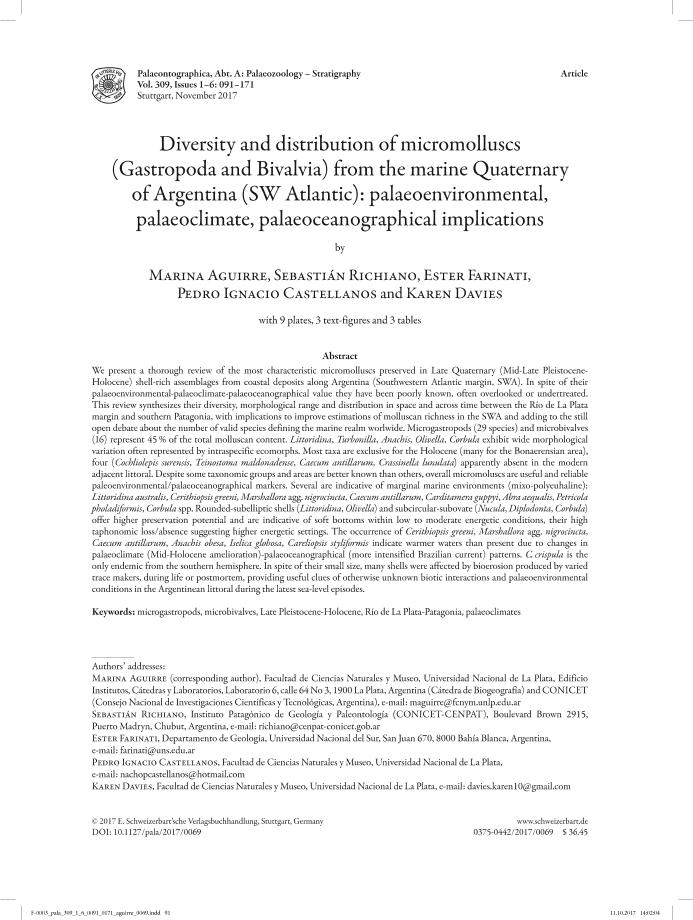Mostrar el registro sencillo del ítem
dc.contributor.author
Aguirre, Marina Laura

dc.contributor.author
Richiano, Sebastián Miguel

dc.contributor.author
Farinati, Ester Amanda

dc.contributor.author
Castellanos, Pedro Ignacio
dc.contributor.author
Davies, Karen
dc.date.available
2018-08-24T14:08:56Z
dc.date.issued
2017-12
dc.identifier.citation
Aguirre, Marina Laura; Richiano, Sebastián Miguel; Farinati, Ester Amanda; Castellanos, Pedro Ignacio; Davies, Karen; Diversity and distribution of micromolluscs (Gastropoda and Bivalvia) from the marine Quaternary of Argentina (SW Atlantic): Palaeoenvironmental, palaeoclimate, palaeoceanographical implications; E Schweizerbartsche Verlags; Palaeontographica; 309; 1-6; 12-2017; 91-171
dc.identifier.issn
0375-0442
dc.identifier.uri
http://hdl.handle.net/11336/56938
dc.description.abstract
We present a thorough review of the most characteristic micromolluscs preserved in Late Quaternary (Mid-Late Pleistocene- Holocene) shell-rich assemblages from coastal deposits along Argentina (Southwestern Atlantic margin, SWA). In spite of their palaeoenvironmental-palaeoclimate-palaeoceanographical value they have been poorly known, often overlooked or undertreated. This review synthesizes their diversity, morphological range and distribution in space and across time between the Rio de La Plata margin and southern Patagonia, with implications to improve estimations of molluscan richness in the SWA and adding to the still open debate about the number of valid species defining the marine realm worlwide. Microgastropods (29 species) and microbivalves (16) represent 45 % of the total molluscan content. Littoridina, Turbonilla, Anachis, Olivella, Corbula exhibit wide morphological variation often represented by intraspecific ecomorphs. Most taxa are exclusive for the Holocene (many for the Bonaerensian area), four (Cochliolepis surensis, Teinostoma maldonadense, Caecum antillarum, Crassinella lunulata) apparently absent in the modern adjacent littoral. Despite some taxonomic groups and areas are better known than others, overall micromoluscs are useful and reliable paleoenvironmental/palaeoceanographical markers. Several are indicative of marginal marine environments (mixo-polyeuhaline): Littoridina australis, Cerithiopsis greeni, Marshallora agg. nigrocincta, Caecum antillarum, Carditamera guppyi, Abra aequalis, Petricola pholadiformis, Corbula spp. Rounded-subelliptic shells (Littoridina, Olivella) and subcircular-subovate (Nucula, Diplodonta, Corbula) offer higher preservation potential and are indicative of soft bottoms within low to moderate energetic conditions, their high taphonomic loss/absence suggesting higher energetic settings. The occurrence of Cerithiopsis greeni, Marshallora agg. nigrocincta, Caecum antillarum, Anachis obesa, Iselica globosa, Careliopsis styliformis indicate warmer waters than present due to changes in palaeoclimate (Mid-Holocene amelioration)-palaeoceanographical (more intensified Brazilian current) patterns. C. crispula is the only endemic from the southern hemisphere. In spite of their small size, many shells were affected by bioerosion produced by varied trace makers, during life or postmortem, providing useful clues of otherwise unknown biotic interactions and palaeoenvironmental conditions in the Argentinean littoral during the latest sea-level episodes.
dc.format
application/pdf
dc.language.iso
eng
dc.publisher
E Schweizerbartsche Verlags

dc.rights
info:eu-repo/semantics/openAccess
dc.rights.uri
https://creativecommons.org/licenses/by-nc-sa/2.5/ar/
dc.subject
Late Pleistocene-Holocene
dc.subject
Microbivalves
dc.subject
Microgastropods
dc.subject
Palaeoclimates
dc.subject
Rio de La Plata-Patagonia
dc.subject.classification
Meteorología y Ciencias Atmosféricas

dc.subject.classification
Ciencias de la Tierra y relacionadas con el Medio Ambiente

dc.subject.classification
CIENCIAS NATURALES Y EXACTAS

dc.title
Diversity and distribution of micromolluscs (Gastropoda and Bivalvia) from the marine Quaternary of Argentina (SW Atlantic): Palaeoenvironmental, palaeoclimate, palaeoceanographical implications
dc.type
info:eu-repo/semantics/article
dc.type
info:ar-repo/semantics/artículo
dc.type
info:eu-repo/semantics/publishedVersion
dc.date.updated
2018-08-24T13:38:48Z
dc.journal.volume
309
dc.journal.number
1-6
dc.journal.pagination
91-171
dc.journal.pais
Alemania

dc.journal.ciudad
Stuttgart
dc.description.fil
Fil: Aguirre, Marina Laura. Consejo Nacional de Investigaciones Científicas y Técnicas. Centro Científico Tecnológico Conicet - La Plata; Argentina. Facultad de Ciencias Naturales y Museo, Universidad Nacional de la Plata; Argentina
dc.description.fil
Fil: Richiano, Sebastián Miguel. Consejo Nacional de Investigaciones Científicas y Técnicas. Centro Nacional Patagónico; Argentina
dc.description.fil
Fil: Farinati, Ester Amanda. Universidad Nacional del Sur. Departamento de Geología; Argentina
dc.description.fil
Fil: Castellanos, Pedro Ignacio. Universidad Nacional de La Plata. Facultad de Ciencias Naturales y Museo; Argentina
dc.description.fil
Fil: Davies, Karen. Universidad Nacional de La Plata. Facultad de Ciencias Naturales y Museo; Argentina
dc.journal.title
Palaeontographica

dc.relation.alternativeid
info:eu-repo/semantics/altIdentifier/doi/http://dx.doi.org/10.1127/pala/2017/0069
dc.relation.alternativeid
info:eu-repo/semantics/altIdentifier/url/https://www.schweizerbart.de/papers/pala/detail/309/88330/Diversity_and_distribution_of_micromolluscs_Gastro?af=crossref
Archivos asociados
